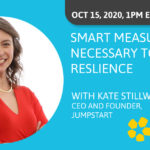We see it happen over and over — a promising social enterprise attracts funding for its early stages but can’t graduate to growth-stage capital when it’s ready to scale.
Social entrepreneurs face significant challenges as they try to cross the “missing middle” of finance, defined by the Aspen Network of Development Entrepreneurs (ANDE) as between $20,000 and $2 million in investment capital. The missing middle affects enterprises too big for micro-finance but not yet attractive to larger commercial finance or strategic investors.
Obstacles to securing funding
Social enterprises, particularly those in developing countries, face a number of headwinds as they scale, including:
- Most impact investors in the missing-middle range seek market-rate, or non-concessionary, returns in addition to measurable impact. The Global Impact Investment Network (GIIN) estimates that 84 percent of impact investors have market-rate or close to market-rate objectives, leaving only 16 percent of funders as authentic impact-first investors.
- As deal sizes grow, investors are increasingly commercial, and social entrepreneurs are left with either venture capitalists or private equity funds seeking returns-only or strategic investments.
- Too often, traditional equity is unsuitable for social enterprises — even though much of the impact investing ecosystem retains a muscle memory that favors equity. As a result, many entrepreneurs spend time seeking equity investments, only to discover that they can’t close the gap between their own and investors’ enterprise valuation expectations.
Learning from success stories
While funding challenges are daunting, they’re not impossible to overcome. What can we learn from enterprises that have closed funding rounds exceeding $2 million?
Recent successes in the energy-access space include:
- Husk Power Systems, provider of mini-grid energy systems in India and Tanzania, announced in January 2018 that it had closed $20 million in equity investment. Keeping the round open for an additional $10 million in equity, Husk Power is also seeking debt investment.
- Off Grid Electric, an off-grid solar solution in Africa, recently closed $55 million in Series D funding from investors including GE Ventures, a commercial/strategic investor. Previously, Off Grid received early market-rate equity impact investment from Double Bottom Line (DBL) Partners.
- M-Kopa raised $80 million last year to fuel its solar power business serving households in Kenya, Tanzania, and Uganda.
- Greenlight Planet raised $60 million for its off-grid energy systems that it sells throughout Africa and India.
Navigating the complex funding landscape typically means learning by doing and finding ways to effectively blend impact, commercial, venture, and philanthropic capital. With Husk Power’s recent funding as the example, social enterprises might want to consider these best practices:
1. Make mistakes.
Midway in its 10-year tenure, a faulty franchise plan forced Husk Power to write off and abandon 35 to 40 micro-grids valued at millions of dollars. Management used this negative experience to recalibrate its business model and establish its expertise in the field.
2. Think big when it comes to funding.
Advisors urged Manoj Sinha, CEO and co-founder of Husk Power, to seek $5 million funding increments. He instead found success in seeking a larger round extended over a longer period of time and with intermediate milestones. He let the business model, operations, and use-of-funds calculations dictate the funding requirements — rather than the perception or reality of a lack of available investment capital.
3. Collect data.
As enterprises scale, the investors they seek will require more hard evidence — and less storytelling — upon which to base their investment decisions.
4. Work with great mentors and build a strong board.
Sinha twice attended the Miller Center for Social Entrepreneurship’s Global Social Benefit Institute (GSBI) programs, where Silicon Valley mentors helped him navigate the challenges of turning the company around. One mentor, Brad Mattson, joined Husk’s board of directors as chairman in 2014 — a time when the company was in the greatest need of assistance.
5. Evolve the business model.
Investors respond positively to a great business model. Be willing to re-evaluate, fine-tune, or abandon a business model if it’s not working — even if it’s been your ‘baby.’
6. Create a list of diversified investors.
Based on a cultivated network and needs assessment, Husk Power constructed a detailed list of 30 diverse investors and had ‘warm’ meetings with all of them. As a result, its three investors — Shell Technology Ventures LLC, Swedish development finance institution Swedfund International, and ENGIE Rassembleurs d’Energies, ENGIE group’s impact investment fund — are very different in nature.
What can those in the investment community do to help? That’s a bigger question overall, but here are a few things investors might consider:
1. Clarify expectations.
Too often, it’s unclear to social enterprises what various funding sources (grant, debt, quasi-equity, and equity) require of them. This includes not only returns, but also the qualifications for each stage of funding and, particularly, what kind of impact these investors expect.
2. Improve handoffs.
In addition to differing expectations, the funding structures and preferences of impact investors and VCs are worlds apart. They don’t need to do each other’s work, but they could help make an enterprise’s transition from seed to later-stage funding more coherent.
3. Consider offering innovative financing approaches.
As an example, the variable payment obligation (VPO) model, championed by the Miller Center and others, provides ways to invest in social enterprises that have promising business or impact models but are too risky for traditional investment approaches. In VPO financing, payments are based on cash flow instead of collateral and fixed monthly payments.
4. Collaborate throughout the social enterprise ecosystem.
Accelerators, incubators, and other ecosystem actors can be valuable resources for better understanding and supporting social enterprises within the constraints of a particular funding model.
5. Set intention first.
Not all forms of impact necessary to achieve global ambitions such as the United Nations Sustainable Development Goals (SDGs) will generate market-rate financial returns, and some cannot realistically generate return of capital. The form of impact an investor seeks should inform what type of capital can reasonably be deployed.
Reducing funding headwinds for social enterprises requires diligence from all ecosystem participants. It is an endeavor well worth the effort, especially if more social enterprises get funded to the full extent of their potential, fueling them to achieve meaningful impact toward creating a better world.





